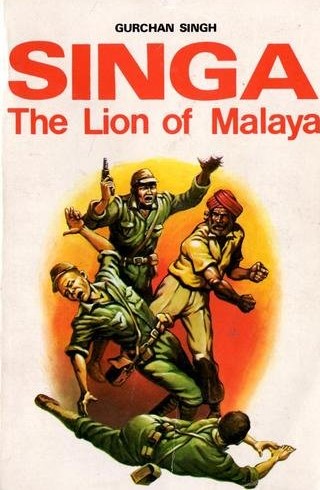Meet 'The Lion Of Malaya' - A Cop Who Silently Fought The Japanese Army During WW2
He was also the personal bodyguard of Tunku Abdul Rahman!
During the Japanese Occupation of Malaya in 1941, Gurchan Singh formed a secret network of nationwide agents to help carry out his anti-Japanese army campaign
In his book, Singa — The Lion of Malaya, Gurchan said that many people of Indian origin joined the Indian National Army (INA) to work with and fight beside the Japanese army following their invasion of Malaya, but he chose to not do so.
The Malayan freedom fighter, who was born in May 1914, studied at Methodist Boys' School, Kuala Lumpur, according to SikhNet.
He then joined the Royal Malaysia Police (PDRM) as a recruit constable after completing his Cambridge examination and became a detective constable five years later.
This blog quoted New Straits Times saying that during Gurchan's service in the force, he was in charge of Japanese nationals who were interning in Malaya.
Despite his outward friendliness towards the Japanese, Gurchan was strongly against the occupation.
Gurchan started his underground campaign against the Japanese army while living with his family, and working as a milkman and cowboy in Kuala Lumpur
New Straits Times reported that Gurchan was on the Kempeitai (Japanese military police) watch list when he moved to the city because he was a police inspector.
So, in order to rally people against the Japanese army's propaganda, Gurchan and his two brothers, Gurcharan and Gurdial, secretly distributed leaflets signed as 'Singa' (Lion) to the people.
These leaflets contained truthful information about the war and the occupation which were not available on Japanese news.
Gurchan's organisation gradually grew, comprising of over 30 agents from all over Malaya, as reported by Free Malaysia Today.
The leaflets were regularly dropped outside residences, and pasted on trees, walls, lamp posts, and noticeboards at night.
Sometimes, Gurchan also organised cycle races to sneak the leaflets under the Kempeitai's noses, by hiding them inside the hollow bars of the bicycles.
This silent campaign eventually led the Japanese army to set a bounty of $100,000 on the head of the resistance leader, whom they knew only as 'Singa'.
Eventually, Gurchan started to mastermind guerrilla operations when he realised that merely propaganda was not enough to cripple the Japanese army's activities
He sabotaged the railways with the help of his friend, John Sandasamy, who was a second-class engine driver with the railways.
Together, they delayed many trains, putting several of them out of action. This messed up the Japanese army's transport system as the movement of their military machines relied heavily on the railway system.
Gurchan and his brothers also cut telecommunication lines and even attacked Japanese soldiers with grenades.
Their sabotage work was of considerable assistance to the Allied powers.
Gurchan Singh — The lion of Malaya.
Image via Sikhs in Malaysia: A Comprehensive History/Free Malaysia TodayThe 'fearless lion of Malaya' also attended a Japanese press conference in Singapore under the guise of a newspaper man from Kuala Lumpur
He then referenced the conference's proceedings in subsequent leaflets.
This prompted the Kempetei to step up their efforts to apprehend Gurchan as they believed that 'Singa' was the name of an organised gang based in the jungles of Malaya.
The Japanese army were also convinced that this gang was in frequent contact with the Allies.
At one point, several Singa agents were executed and tortured by the Japanese army after they were caught with leaflets, but all of them kept mum and protected Gurchan by not revealing that it was the former policeman who was heading the operation.
Unfortunately, Gurchan was betrayed by someone in the secret network, putting an end to his propaganda efforts
But his luck prevailed and he managed to escape when the Kempeitai came to arrest him at his home on Jalan Gallagher, Kuala Lumpur, on 4 March 1945.
The Kempeitai invaded his house just before midnight, while he was asleep. Even so, Gurchan quickly realised what was happening and put up a fierce fight, knocking out three armed guards before escaping.
He took off his turban, cut his hair, shaved off his beard, and joined the infamous Death Railway — that stretched from Siam to Burma — workforce under an assumed name.
After the war ended, he returned to his family in Kuala Lumpur and resumed his career in the force. He was then promoted to Inspector and later to Superintendent of Police.
Apart from that, the High Commissioner Edward Gent awarded Gurchan a certificate of commendation for his heroic acts.
Gurchan led a very interesting and daring life. Here are some fun facts about the 'Lion of Malaya':
– He was the founder and honorary secretary of the Malayan Cyclists Federation, established in December 1953.
– He kickstarted the formation of the Asian Cycling Federation in August 1962.
– Gurchan was elected as president of the federation which has members from countries such as Indonesia, Japan, the Philippines, Taiwan, Iran, Hong Kong, and Thailand.
– According to New Straits Times, he was nearly bitten by a crocodile when he was less than six months old.
– At seven, he almost drowned and three years later, he nearly stepped on a fallen live electrical cable.
– In 1933, he survived after falling off a cliff while climbing Mount Everest.
– He also ended up becoming the principal security officer or aide-de-camp (ADC) and bodyguard of Tunku Abdul Rahman.
Sadly, the 'Lion of Malaya' died in an accident in Johor, while on official business for the Prime Minister in 1965.
His wartime efforts were also documented in the book Heroes of Malaya, which was widely used in Malayan schools in the 1950s.


